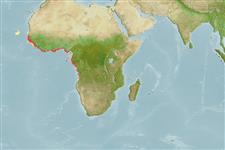>
Carangiformes (Jacks) >
Carangidae (Jacks and pompanos) > Trachinotinae
Etymology: Trachinotus: Greek, trachys, -eia, -ys = rough + Greek,noton = back (Ref. 45335).
More on author: Cuvier.
Environment: milieu / climate zone / depth range / distribution range
Ecologie
marien; brak water; diepte 0 - 100 m (Ref. 27000). Tropical; 20°N - 20°S
Eastern Atlantic: west coast of Africa, from Senegal to the Congo estuary (Ref. 57392).
Grootte / Gewicht / Leeftijd
Maturity: Lm ? range ? - ? cm
Max length : 60.0 cm TL mannelijk / geslacht onbekend; (Ref. 57392); common length : 30.0 cm TL mannelijk / geslacht onbekend; (Ref. 2683)
Dorsale stekels (totaal) : 7; Dorsale zachte stralen (totaal) : 20 - 23; Anale stekels: 3; Anale zachte stralen: 18 - 21. Diagnosis: body short and deep (its depth 1.8-2.6 times in fork length), lozenge-shaped and strongly compressed; front of head arched; snout rounded; upper jaw extending almost to below hind margin of eye; 11-13 gill rakers on lower limb of first gill arch (Ref. 57392). 2 dorsal fins, 1st with 6 spines, 2nd with 1 spine and 20-23 soft rays; anal fin with 2 short, detached spines followed by 1 spine and 18-21 soft rays (Ref. 57392, 81654). Lobes of soft dorsal and anal fins strongly developed and falcate, longer than head at sizes over 10 cm (Ref. 57392), dorsal fin lobe 1.8-3.2 times in fork length (Ref. 81654). Pectoral fins shorter than head; scales small, cycloid and partially embedded in skin; lateral line scarcely arched over pectoral fins, without scutes (Ref. 57392). 4-6 (usually 5) black spots distributed all along lateral line (in specimens longer than 7-9 cm fork length) (Ref. 57392, 81654).
Coloration: back greenish, sides silvery, with 4-6 (usually 5) dark spots regularly spaced along lateral line, 1st as a vertical line, others oval to circular and becoming progressively smaller backwards; dorsal- and anal-fin lobes dark, caudal fin dark, but light-edged distally; these spots absent or indistinct in juveniles smaller than 100 mm (Ref. 57392).
Coastal marine species (Ref. 2683, 57392) occurring down to 100 m depth (Ref. 57392), frequently entering estuaries (Ref. 2683, 57392) and ascending lower courses of rivers (Ref. 57392). Maximum length possibly up to 100 cm (Ref. 57392).
Levenscyclus en paargedrag
Maturiteit | Voortplanting | Paaien | Eieren | Fecunditeit | Larven
Smith-Vaniz, W.F. and F.H. Berry, 1981. Carangidae. In W. Fischer, G. Bianchi and W.B. Scott (eds.) FAO species identification sheets for fishery purposes. Eastern Central Atlantic (fishing areas 34, 47 (in part) . Vol. 1. (Ref. 3195)
Status op de Rode Lijst van het IUCN (Ref. 130435: Version 2024-2)
Gevaar voor de mens
Harmless
Gebruik door de mens
Visserij: van minder commercieel belang
Tools
Speciale rapporten
Download XML
Internetbronnen
Estimates based on models
Preferred temperature (Ref.
123201): 19.2 - 28, mean 26.2 °C (based on 100 cells).
Fylogenetische diversiteitsindex (Ref.
82804): PD
50 = 0.5000 [Uniqueness, from 0.5 = low to 2.0 = high].
Bayesian length-weight: a=0.01549 (0.00697 - 0.03443), b=2.78 (2.60 - 2.96), in cm total length, based on LWR estimates for this species & Genus-body shape (Ref.
93245).
Trofisch niveau (Ref.
69278): 3.7 ±0.5 se; based on size and trophs of closest relatives
Weerstandsvermogen (Ref.
120179): Gemiddeld, minimale populatieverdubbelingstijd 1,4-4,4 jaar (Preliminary K or Fecundity.).
Fishing Vulnerability (Ref.
59153): Moderate vulnerability (44 of 100).
Nutrients (Ref.
124155): Calcium = 120 [53, 258] mg/100g; Iron = 1.39 [0.74, 2.96] mg/100g; Protein = 19.1 [17.1, 21.2] %; Omega3 = 0.23 [0.12, 0.45] g/100g; Selenium = 49.9 [21.8, 111.1] μg/100g; VitaminA = 10.3 [2.6, 37.9] μg/100g; Zinc = 0.987 [0.635, 1.556] mg/100g (wet weight);
